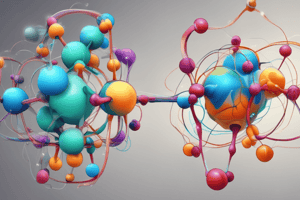Podcast
Questions and Answers
What type of bond involves the transfer of electrons from one atom to another?
What type of bond involves the transfer of electrons from one atom to another?
- Ionic Bonding (correct)
- Covalent Bonding
- Metallic Bonding
- Polar Bonding
Which type of bond is characterized by the sharing of electron pairs?
Which type of bond is characterized by the sharing of electron pairs?
- Ionic Bonding
- Metallic Bonding
- Hydrogen Bonding
- Covalent Bonding (correct)
What is the relationship between bond length and bond strength?
What is the relationship between bond length and bond strength?
- Unrelated
- Directly proportional
- Dependent on the type of bond
- Inversely proportional (correct)
Which molecule would demonstrate a double covalent bond?
Which molecule would demonstrate a double covalent bond?
According to VSEPR theory, what is the molecular geometry of a molecule with four bonding pairs?
According to VSEPR theory, what is the molecular geometry of a molecule with four bonding pairs?
Which type of bonding involves delocalized electrons over a lattice structure?
Which type of bonding involves delocalized electrons over a lattice structure?
What kind of bond results in partial positive and negative charges due to unequal electron sharing?
What kind of bond results in partial positive and negative charges due to unequal electron sharing?
Which of the following is a consequence of hybridization in molecules?
Which of the following is a consequence of hybridization in molecules?
What role does chemical bonding play in determining the properties of substances?
What role does chemical bonding play in determining the properties of substances?
Which of the following statements is true about bond energy?
Which of the following statements is true about bond energy?
Flashcards are hidden until you start studying
Study Notes
Chemical Bonding
Types of Chemical Bonds
-
Ionic Bonding
- Occurs between metals and nonmetals.
- Involves transfer of electrons from one atom to another.
- Results in formation of charged ions (cations and anions).
- Strong electrostatic forces hold ions together.
- Example: Sodium chloride (NaCl).
-
Covalent Bonding
- Involves sharing of electron pairs between atoms.
- Typically occurs between nonmetals.
- Can be single, double, or triple bonds based on the number of shared electron pairs.
- Example: Water (H₂O) has single bonds; Oxygen (O₂) has a double bond.
-
Metallic Bonding
- Occurs between metal atoms.
- Involves a “sea of electrons” that are delocalized over a lattice of metal cations.
- Contributes to properties like electrical conductivity and malleability.
- Example: Copper (Cu).
Bond Characteristics
- Bond Length: The distance between the nuclei of two bonded atoms; inversely related to bond strength.
- Bond Energy: The energy required to break a bond between two atoms; higher bond energy indicates a stronger bond.
- Polarity:
- Nonpolar covalent bonds involve equal sharing of electrons (e.g., Cl₂).
- Polar covalent bonds involve unequal sharing, leading to partial positive and negative charges (e.g., HCl).
Lewis Structures
- Simplified representations of molecules showing valence electrons.
- Helps predict molecular shape, bond angles, and polarity.
- Involves:
- Valence electron counting.
- Placement of bonding and lone pairs.
Molecular Geometry
-
VSEPR Theory (Valence Shell Electron Pair Repulsion)
- Used to predict the 3D shape of molecules.
- Based on the repulsion between electron pairs.
- Common geometries include:
- Linear (180°)
- Trigonal planar (120°)
- Tetrahedral (109.5°)
-
Hybridization
- Mixing of atomic orbitals to form new hybrid orbitals.
- Types include:
- sp (linear)
- sp² (trigonal planar)
- sp³ (tetrahedral)
Importance of Chemical Bonding
- Determines the physical and chemical properties of substances.
- Affects reactivity, state of matter, and molecular function in biological systems.
Types of Chemical Bonds
- Ionic Bonding: Occurs between metals and nonmetals, involves the transfer of electrons, forming charged ions (cations and anions) held together by strong electrostatic forces. Example: NaCl
- Covalent Bonding: Involves sharing of electron pairs between atoms, typically between nonmetals, can be single, double, or triple bonds based on the number of shared electron pairs. Example: H₂O has single bonds, O₂ has a double bond
- Metallic Bonding: Occurs between metal atoms, involves a "sea of electrons" delocalized over a lattice of metal cations, responsible for electrical conductivity and malleability. Example: Copper (Cu)
Bond Characteristics
- Bond Length: Distance between two bonded atoms' nuclei, inversely related to bond strength
- Bond Energy: Energy required to break a bond, higher energy indicates stronger bond
- Polarity: Nonpolar covalent bonds involve equal sharing of electrons (e.g., Cl₂), polar covalent bonds involve unequal sharing, leading to partial positive and negative charges (e.g., HCl).
Lewis Structures
- Simplified representations of molecules showing valence electrons
- Help predict molecular shape, bond angles, and polarity
- Involve valence electron counting and placement of bonding and lone pairs
Molecular Geometry
- VSEPR Theory: Predicts 3D shape of molecules based on electron pair repulsion, common geometries include:
- Linear (180°)
- Trigonal planar (120°)
- Tetrahedral (109.5°)
Importance of Chemical Bonding
- Determines physical and chemical properties of substances
- Affects reactivity, state of matter, and molecular function in biological systems
Studying That Suits You
Use AI to generate personalized quizzes and flashcards to suit your learning preferences.




